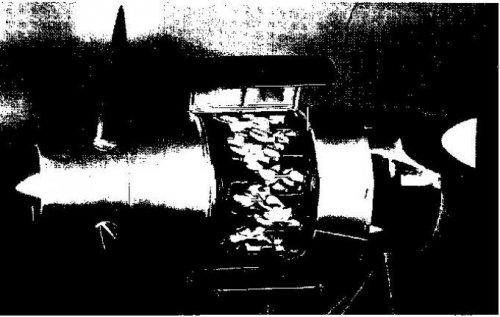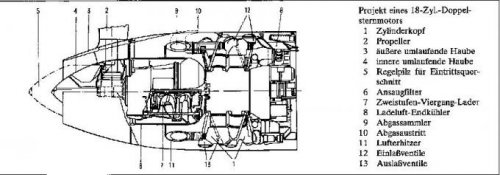Johnbr
ACCESS: Top Secret
- Joined
- 6 May 2007
- Messages
- 752
- Reaction score
- 283
D's any one have info on this bmw ww2 aircraft engine.
The project is one of the 18-cylinder air-cooled engines made in a double star being developed by BMW. 1. The cylinder head. 2. The propeller. 3. The outer skin. 4. The inner lining. 5. The regulator inlet. 6. The air filter inlet to create a fuel-air mixture. 7. The two-stage four-speed blower. 8. The final charge air cooler. 9. An exhaust manifold. 10. The exhaust gas ejection port. 11. The heater filter. 12. The inlet valve. 13. The exhaust valve.projects P-8010 / P-8013 had the fairing with adjustable air inlets and placed before the cylinder 2-stage blowers. The total length of the motor gondolas these engines is about 3.3 meters, diameter of 1.45 meters.
The draft of a 18-cylinder engines air cooling performed by double star circuit develops by BMW.
1. The cylinder head.
2. The propeller.
3. The outer casing.
4. Inner lining.
5. The regulator inlet.
6. The filter for cleaning the air inlet to create a fuel-air mixture.
7. A 2-stage four-speed blower.
8. The final charge air cooler.
9. The exhaust manifold.
10. The exhaust gas ejection hole.
11. Heater filter.
12. The inlet valve.
13. The discharge valve.
The project is one of the 18-cylinder air-cooled engines made in a double star being developed by BMW. 1. The cylinder head. 2. The propeller. 3. The outer skin. 4. The inner lining. 5. The regulator inlet. 6. The air filter inlet to create a fuel-air mixture. 7. The two-stage four-speed blower. 8. The final charge air cooler. 9. An exhaust manifold. 10. The exhaust gas ejection port. 11. The heater filter. 12. The inlet valve. 13. The exhaust valve.projects P-8010 / P-8013 had the fairing with adjustable air inlets and placed before the cylinder 2-stage blowers. The total length of the motor gondolas these engines is about 3.3 meters, diameter of 1.45 meters.
The draft of a 18-cylinder engines air cooling performed by double star circuit develops by BMW.
1. The cylinder head.
2. The propeller.
3. The outer casing.
4. Inner lining.
5. The regulator inlet.
6. The filter for cleaning the air inlet to create a fuel-air mixture.
7. A 2-stage four-speed blower.
8. The final charge air cooler.
9. The exhaust manifold.
10. The exhaust gas ejection hole.
11. Heater filter.
12. The inlet valve.
13. The discharge valve.


